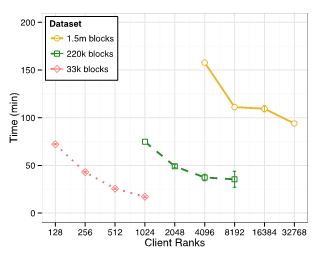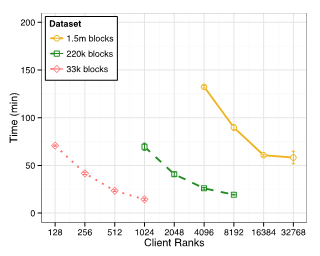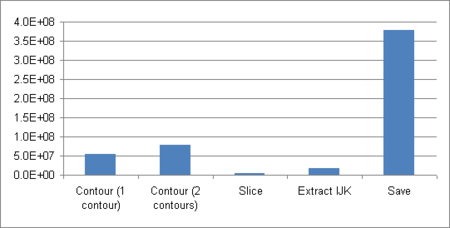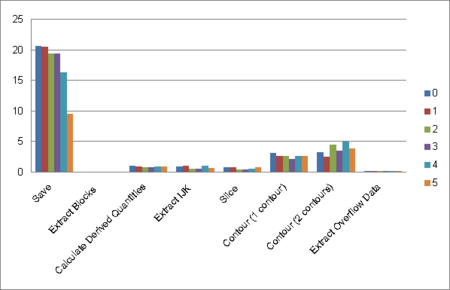ParaView/Catalyst/Overview: Difference between revisions
Andy.bauer (talk | contribs) |
m (smaller in size not in time to save) |
||
| (28 intermediate revisions by 2 users not shown) | |||
| Line 1: | Line 1: | ||
<center>[[File:CatalystLogo.png|500px]]</center> | <center>[[File:CatalystLogo.png|500px]]</center> | ||
== Background == | == Background == | ||
Several factors are driving the growth of simulations. Computational power of computer clusters is growing, while the price of individual computers is decreasing. Distributed computing techniques allow hundreds, or even thousands, of computer nodes to participate in a single simulation. The benefit of this computational power is that simulations are | Several factors are driving the growth of simulations. Computational power of supercomputers and computer clusters is growing, while the price of individual computers is decreasing. Distributed computing techniques allow hundreds, or even thousands, of computer nodes to participate in a single simulation. The benefit of this computational power is that simulations are becoming more accurate and useful for predicting complex phenomena. The downside to this growth is the enormous amounts of data that need to be saved and analyzed to determine the results of the simulation. Unfortunately, the growth of IO capabilities has not kept up with the growth of processing power in these machines. Thus, the ability to generate data has outpaced our ability to save and analyze the data. This bottleneck is throttling our ability to benefit from our improved computing resources. For example, simulations often save their states infrequently to minimize storage requirements. | ||
Such coarse temporal sampling makes it difficult to notice some complex behavior. To address this issue, ParaView can now be easily used to integrate concurrent analysis and visualization directly into simulation codes. This functionality is often referred to as co-processing, ''in situ'' processing or co-visualization. | |||
This feature is available through ParaView Catalyst (previously called ParaView Co-Processing). The workflows comparing the old to the new simulation workflow using ParaView Catalyst can be seen in the figure below. | |||
{| | |||
|[[Image:FullWorkFlow.png|thumb|800px|Full Workflow]] | |||
|} | |||
{| | |||
|[[Image:CatalystWorkFlow.png|thumb|800px|Workflow With Co-Processing]] | |||
|} | |||
== Technical Objectives == | == Technical Objectives == | ||
The main objective of the co-processing toolset is to | The main objective of the co-processing toolset is to facilitate integration of easy to use, core data processing into the simulation to enable scalable data analysis. The toolset has two main parts: | ||
* '''An extensible and flexible library''': ParaView Catalyst was designed to be flexible enough to be embedded in various simulation codes with relative ease and minimal footprint. This flexibility is critical, as a library that requires | * '''An extensible and flexible library''': ParaView Catalyst was designed to be flexible enough to be embedded in various simulation codes with relative ease and minimal footprint. This flexibility is critical, as a library that requires significant effort to embed cannot be successfully deployed in a large number of simulations. The co-processing library is also easily-extended so that users can deploy new analysis and visualization techniques to existing co-processing installations. The minimal footpring is through using the Catalyst configuration tools (see directions for [[Generating_Catalyst_Source_Tree|generating source]] and [[Build_Directions| building]]) to reduce the overall amount of ParaView and VTK libraries that a simulation code needs to link to. | ||
* '''Configuration tools for ParaView Catalyst output''': It is important for users to be able to configure the Catalyst output using graphical user interfaces that are part of their daily work-flow. | * '''Configuration tools for ParaView Catalyst output''': It is important for users to be able to configure the Catalyst output using graphical user interfaces that are part of their daily work-flow. | ||
Note: All of this | Note: All of this can be done for large data. The Catalyst library will often be used on a distributed system. For the largest simulations, the visualization of extracts may also require a distributed system (i.e. a visualization cluster). | ||
== Details == | |||
Using ParaView Catalyst is a fundamental change in to the way that simulation results are obtained. The entire | |||
goal is to reduce the time to gaining insight into the problem being simulated. Figure 1 shows | |||
the computational time perform a full workflow using Sandia's CTH simulation code for various problem sizes and process counts. | |||
This time includes both simulation and post-processing simulation time. Figure 2 shows the execution time for gaining the same results with CTH while using Catalyst for ''in situ'' analysis and visualization. | |||
{| | |||
|[[Image:CTHFullWorkflow.png|thumb|400px|Figure 1: Classical workflow.]] || [[Image:CTHCatalystWorkflow.png|thumb|400px|Figure 2: Catalyst workflow.]] | |||
|} | |||
Note that as the problem size increases as well as the number of processes increases, the benefits of using Catalyst | |||
become more apparent. This is due in a large part because the computing system resources are being stretched to | |||
their limit and inefficiencies become more apparent. This is detailed in Sandia's SAND2010-6118 technical report which is referenced below. One possible workflow that ParaView's co-processing tools | |||
enables is demonstrated more fully in Figure 3. | |||
{| | |||
|[[Image:CatalystFullWorkFlow.png|650px|thumb|left|Figure 3: Full workflow.]] | |||
|} | |||
In this workflow the user creates a Python script using ParaView's plugin for creating Catalyst co-processing scripts. Here the user can choose a variety of outputs: extracted data such as polygonal output with field data, rendered images, plot information and/or statistics. The Python scripts are then used by Catalyst during the simulation run to output the simulation user's desired information. Typically, the extracted data is orders of magnitude smaller than the full raw data set. This is shown in Figure 4 for a relatively small problem for several VTK filters. | |||
Often the reduced file IO also results in faster simulation runs since in certain cases it is faster | |||
for Catalyst to compute a desired extract and save that to disk compared to just saving the full raw data | |||
to disk. Figure 5 shows the compute time for certain VTK filters compared to saving the full raw data for a small 6 process run. | |||
{| | |||
|[[Image:CatalystReduceOutputSize.png|450px|thumb|Figure 4: Extract file size compared to full raw data.]] || | |||
[[Image:CatalystReduceRunTime.png|450px|thumb|Figure 5: Time to compute extracts compared to file IO.]] | |||
|} | |||
== Important Links == | == Important Links == | ||
* The [http://catalyst.paraview.org main page] for ParaView Catalyst. | * The [http://catalyst.paraview.org main page] for ParaView Catalyst. | ||
* The most complete information is available in the [ | * The most complete information is available in the [http://www.paraview.org/files/catalyst/docs/ParaViewCatalystUsersGuide_v2.pdf ParaView Catalyst User's Guide]. | ||
* [https://github.com/ | * [https://github.com/Kitware/ParaViewCatalystExampleCode Example code] with samples from Python, C, C++ and Fortran for creating adaptors as well as examples of hard-coded C++ Catalyst pipelines. | ||
* A [[Media:ParaViewCatalystV1Tutorial.pdf|tutorial]] on ParaView Catalyst. | * A [http://vimeo.com/75793492|video webinar] on ParaView Catalyst from September 26, 2013. | ||
* A [[Media:ParaViewCatalystV1Tutorial.pdf|tutorial]] on ParaView Catalyst along with [[Media:ParaViewCatalystV1TutorialFiles.tgz|sample files]]. | |||
* Directions on how to [[ParaView/Catalyst/BuildCatalyst|build ParaView Catalyst]]. | |||
* Sandia National Laboratories SAND2013-1122 technical report on [http://www.sandia.gov/~kmorel/documents/MilestoneFY13.pdf Data Co-Processing for Extreme Scale Analysis Level II ASC Milestone]. | |||
* Sandia National Laboratories SAND2010-6118 technical report on [http://www.sandia.gov/~kmorel/documents/MilestoneFY10Sandia.pdf Visualization on Supercomputing Platform Level II ASC Milestone]. | |||
Information for ParaView's original co-processing tools are still [[CoProcessing|available]] but are for versions of ParaView before 4.0. | |||
== Acknowledgements == | |||
{| | |||
| [[Image:SandiaLogo.png]] || || Ken Moreland is the project lead for Sandia. Sandia has contributed significantly to the project both in development and vision. Sandia developers included Nathan Fabian and Ken Moreland. | |||
|- | |||
| [[Image:LANLLogo.png]] || || Jim Ahrens is the project lead at LANL. The LANL team has been integrating Catalyst with various LANL | |||
simulation codes and has contributed to the development of the library. | |||
|- | |||
| [[Image:ArmySBIRLogo.png ]] || || Mark Potsdam, from Aeroflightdynamics Directorate, was the main technical point of contact for Army SBIRs and along with Andy Wissink has contributed significantly to the vision of Catalyst. | |||
|} | |||
Latest revision as of 14:54, 24 March 2016
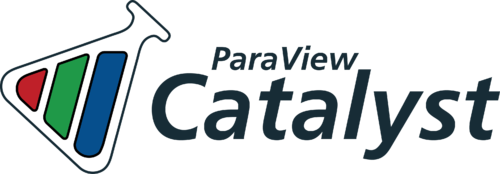
Background
Several factors are driving the growth of simulations. Computational power of supercomputers and computer clusters is growing, while the price of individual computers is decreasing. Distributed computing techniques allow hundreds, or even thousands, of computer nodes to participate in a single simulation. The benefit of this computational power is that simulations are becoming more accurate and useful for predicting complex phenomena. The downside to this growth is the enormous amounts of data that need to be saved and analyzed to determine the results of the simulation. Unfortunately, the growth of IO capabilities has not kept up with the growth of processing power in these machines. Thus, the ability to generate data has outpaced our ability to save and analyze the data. This bottleneck is throttling our ability to benefit from our improved computing resources. For example, simulations often save their states infrequently to minimize storage requirements.
Such coarse temporal sampling makes it difficult to notice some complex behavior. To address this issue, ParaView can now be easily used to integrate concurrent analysis and visualization directly into simulation codes. This functionality is often referred to as co-processing, in situ processing or co-visualization. This feature is available through ParaView Catalyst (previously called ParaView Co-Processing). The workflows comparing the old to the new simulation workflow using ParaView Catalyst can be seen in the figure below.
Technical Objectives
The main objective of the co-processing toolset is to facilitate integration of easy to use, core data processing into the simulation to enable scalable data analysis. The toolset has two main parts:
- An extensible and flexible library: ParaView Catalyst was designed to be flexible enough to be embedded in various simulation codes with relative ease and minimal footprint. This flexibility is critical, as a library that requires significant effort to embed cannot be successfully deployed in a large number of simulations. The co-processing library is also easily-extended so that users can deploy new analysis and visualization techniques to existing co-processing installations. The minimal footpring is through using the Catalyst configuration tools (see directions for generating source and building) to reduce the overall amount of ParaView and VTK libraries that a simulation code needs to link to.
- Configuration tools for ParaView Catalyst output: It is important for users to be able to configure the Catalyst output using graphical user interfaces that are part of their daily work-flow.
Note: All of this can be done for large data. The Catalyst library will often be used on a distributed system. For the largest simulations, the visualization of extracts may also require a distributed system (i.e. a visualization cluster).
Details
Using ParaView Catalyst is a fundamental change in to the way that simulation results are obtained. The entire goal is to reduce the time to gaining insight into the problem being simulated. Figure 1 shows the computational time perform a full workflow using Sandia's CTH simulation code for various problem sizes and process counts. This time includes both simulation and post-processing simulation time. Figure 2 shows the execution time for gaining the same results with CTH while using Catalyst for in situ analysis and visualization.
Note that as the problem size increases as well as the number of processes increases, the benefits of using Catalyst become more apparent. This is due in a large part because the computing system resources are being stretched to their limit and inefficiencies become more apparent. This is detailed in Sandia's SAND2010-6118 technical report which is referenced below. One possible workflow that ParaView's co-processing tools enables is demonstrated more fully in Figure 3.
In this workflow the user creates a Python script using ParaView's plugin for creating Catalyst co-processing scripts. Here the user can choose a variety of outputs: extracted data such as polygonal output with field data, rendered images, plot information and/or statistics. The Python scripts are then used by Catalyst during the simulation run to output the simulation user's desired information. Typically, the extracted data is orders of magnitude smaller than the full raw data set. This is shown in Figure 4 for a relatively small problem for several VTK filters. Often the reduced file IO also results in faster simulation runs since in certain cases it is faster for Catalyst to compute a desired extract and save that to disk compared to just saving the full raw data to disk. Figure 5 shows the compute time for certain VTK filters compared to saving the full raw data for a small 6 process run.
Important Links
- The main page for ParaView Catalyst.
- The most complete information is available in the ParaView Catalyst User's Guide.
- Example code with samples from Python, C, C++ and Fortran for creating adaptors as well as examples of hard-coded C++ Catalyst pipelines.
- A webinar on ParaView Catalyst from September 26, 2013.
- A tutorial on ParaView Catalyst along with sample files.
- Directions on how to build ParaView Catalyst.
- Sandia National Laboratories SAND2013-1122 technical report on Data Co-Processing for Extreme Scale Analysis Level II ASC Milestone.
- Sandia National Laboratories SAND2010-6118 technical report on Visualization on Supercomputing Platform Level II ASC Milestone.
Information for ParaView's original co-processing tools are still available but are for versions of ParaView before 4.0.


